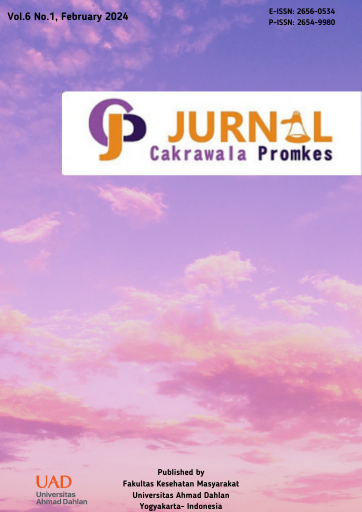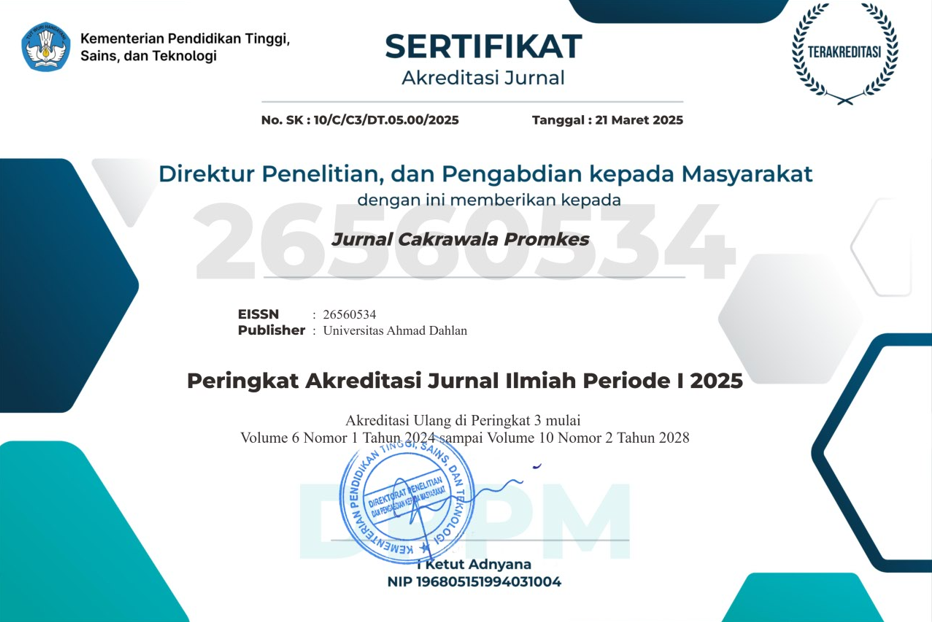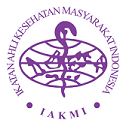The relationship between eating patterns and physical activity with obesity among elementary school children: A case-control study
DOI:
https://doi.org/10.12928/jcp.v6i1.9601Keywords:
Children, Diet, Physical activity, ObesityAbstract
In broad terms, eating patterns encompass three primary components: the type of food consumed, the frequency of eating occasions, and the portion sizes consumed. Schools are recognized as pivotal settings for initiatives aimed at preventing obesity, particularly given the potential for multifaceted interventions when addressing obesity and its associated health issues in childhood. These interventions may involve diverse strategies targeting dietary habits, physical activity levels, and broader environmental factors within the school setting. In local data between 2017 and 2020, the Province of Yogyakarta reported a 6.01% increase in the prevalence of obesity, with Yogyakarta City having the highest rate at 14.73%. This study aimed to investigate the connection between obesity in elementary school students and their eating habits and physical activity levels. This study uses a case-control methodology and is an analytical observational investigation. Purposive sampling was used in the sampling process, with 20 kids serving as the case group and 40 as the control group. Data was obtained using the formulas for physical activity, meal frequency, and 24-hour recall. The Chi-square test was used to examine the results. The results show the relationship between physical activity and eating patterns. Also, children with low physical activity have a 1.14 times greater risk of developing obesity than children who have moderate physical activity. The study's findings suggest a clear correlation between obesity dietary choices and physical activity levels. Effective management of an individual's weight necessitates involvement from their family in regulating their eating habits and encouraging physical exercise. Thus, it can be inferred that eating behaviors and levels of physical activity significantly contribute to the development and management of obesity.
References
Lobstein T BH. World Obesity Federation. London: Atlas of childhood obesity; 2019.
Jebeile H, Cardel MI, Kyle TK JA. Addressing psychosocial health in the treatment and care of adolescents with obesity. Obes (Silver Spring). 2021;29:1413–1422.
Spinelli A, Buoncristiano M, Kovacs VA, Yngve A, Spiroski I, Obreja G, et al. Prevalence of severe obesity among primary school children in 21 European countries. Obesity Facts. 2019;12:244–58.
Cynthia L. Ogden ; Cheryl D. Fryar, MSPH1; Crescent B. Martin; David S. Freedman; Margaret D. Carroll ; Qiuping Gu; Craig M. Hales. Trends in obesity prevalence by race and Hispanic origin—1999-2000 to 2017-2018. JAMA. 2020;324:1208–10.
World Health Organization. Obesity and Overweight. 2018.
Indonesian Ministry of Health. Basic Health Research (Riskesdas) 2018. Jakarta; 2018.
Yogyakarta City Health Service. Yogyakarta Nutrition Status Data 2020. 2020.
Horesh A, Tsur AM, Bardugo A TG. Adolescent and childhood obesity and excess morbidity and mortality in young adulthood—a systematic review. Curr Obes Rep. 2021;10:301–10.
Bustan. Epidemiology of Non-Communicable Diseases. Jakarta: Rineka Cipta; 2007.
Jing Zhang MD, Jing Zhang MD, YunTing Zhang MD, YanRui Jiang MD, WanQi Sun MD, Qi Zhu BA, Patrick Ip MD, DongLan Zhang MD, PhD, ShiJian Liu PhD, Chang Chen BA, Jie Chen MD, Lei Zhang MD, Hao Zhang MD, MingYu Tang MD, WenFang Dong MD, YuFeng Wu MD, Yong Yi FJM. Effect of Sleep Duration, Diet, and Physical Activity on Obesity and Overweight Elementary School Students in Shanghai. J Sch Health. 2018;88:112–21.
Sugiyono. Qualitative and Quantitative Research Methodology in the Health Sector. Yogyakarta: Nuha Medika.; 2019.
IPAQ. Guidelines for Data Processing and Analysis of The International Physical Activity Questionnaire (IPAQ). 2005.
Maesarah et al. . Eating Patterns and the Incidence of Obesity in Elementary School Children in Gorontalo Regency. J Nutrition and Health. 2019;3(20), 55-:55–8.
Karki A, Shrestha A, Subedi N. Prevalence and associated factors of childhood overweight/obesity among primary school children in urban Nepal. 2019;19:1–12.
Istiany, Ari. R. Applied Nutrition. Bandung: PT Teen Rosdakarya.; 2014.
Sriwahyuni, Noyumala, Tangkelayuk V. The Relationship between Diet and the Incidence of Obesity in Children. J Mother Child Care. 2021;6:91–8.
Mahumud RA, Sahle BW, Owusu-Addo E, Chen W, Morton RL RA. Association of dietary intake, physical activity, and sedentary behavior with overweight and obesity among 282,213 adolescents in 89 low and middle income to high-income countries. Int J Obesity. 2021;45:2404–18.
Liu D, Zhao LY, Yu DM, Ju LH, Zhang J, Wang JZ, et al. Dietary patterns and association with obesity of children aged 6–17 years in medium and small cities in China: Findings from the CNHS 2010–2012. Nutrients. 2019;11:1–12.
Jannah, M, & Utami T. Factors that influence the occurrence of obesity in school children at SD NI Sigli, Pidie Regency. J Health Glob. 2018;1:110–8.
Farooq A, Martin A, Janssen X, Wilson MG, Gibson AM, Hughes A, et al. Longitudinal changes in moderate-to-vigorous-intensity physical activity in children and adolescents: A systematic review and meta-analysis. Obes Rev. 2020;21:1–15.
Steene-Johannessen J, Hansen BH, Dalene KE, Kolle E, Northstone K, Møller NC, et al. Variations in accelerometry measured physical activity and sedentary time across Europe-harmonized analyzes of 47,497 children and adolescents. Int J Behav Nutr Phys Act. 2020;17:1–14.
O'Malley GC, Shultz SP, Thivel D, Tsiros MD. Neuromusculoskeletal Health in Pediatric Obesity: Incorporating Evidence into Clinical Examination. Curr Obes Rep. 2021;10:467–77.
Stoner L, Beets MW, Brazendale K, Moore JB WR. Exercise dose and weight loss in adolescents with overweight–obesity: a meta-regression. Sport Med. 2019;49:83–94.
Bushman BA. Developing the P (for Progression) in a FITT-VP Exercise Prescription. ACSM's Heal Fit J 2018;226–9. 2018;22:6–9.
Downloads
Published
Issue
Section
License
Copyright (c) 2024 Ashma Lathifah, Hariza Adnani, Wor Mi Thi

This work is licensed under a Creative Commons Attribution-ShareAlike 4.0 International License.
Authors who publish with JCP: Jurnal Cakrawala Promkes agree to the following terms:
- Authors retain copyright and grant the journal the right of first publication with the work simultaneously licensed under a Creative Commons Attribution License (CC BY-SA 4.0) that allows others to share the work with an acknowledgement of the work's authorship and initial publication in this journal.
- Authors are able to enter into separate, additional contractual arrangements for the non-exclusive distribution of the journal's published version of the work (e.g., post it to an institutional repository or publish it in a book), with an acknowledgement of its initial publication in this journal.
- Authors are permitted and encouraged to post their work online (e.g., in institutional repositories or on their website) prior to and during the submission process, as it can lead to productive exchanges, as well as earlier and greater citation of published work.

This work is licensed under a Creative Commons Attribution-ShareAlike 4.0 International License












